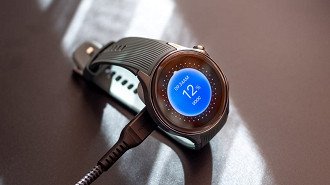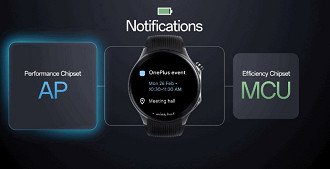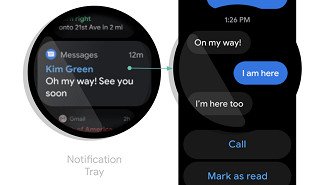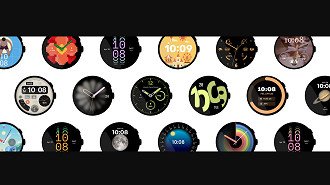New smartwatches with Wear OS 4 from an impressive brand have been released, such as the OnePlus Watch 2 which boasts a battery life of up to 100 hours under typical usage. This extended duration is made possible by a hybrid interface developed through the collaboration between Google and OnePlus.

By utilizing a two-chip design alongside Google’s hybrid interface for Wear OS 4, it is feasible to notably enhance battery life in smartwatches. This innovation enables extending the device’s usage time to around 100 hours under normal conditions while still maintaining full functionality in “smart mode”.
Chipsets architecture operation 2
Smartwatches using Wear OS feature a two-chip structure, involving a separate processor for applications (AP) and a low-power microcontroller co-processor (MCU). This hardware setup, combined with the Wear OS hybrid interface, allows for efficient data processing by intelligently switching between the AP and MCU to reduce energy consumption.

Google collaborated with smartwatch manufacturers to achieve high optimization, resulting in smooth transitions between heavy and light usage.
Connectivity-related procedures and alerts
Energy efficiency was significantly enhanced by utilizing the two-chip architecture and hybrid interface of Wear OS for applications that rely on mobile connection and notifications with different frequencies. This can be seen in the relay notifications displayed from mobile to smartwatch, where the AP chipset is deactivated to save power.
The notifications can be viewed or dismissed by the user with just the low-energy MCU chipset. The MCU chipset alone can also be used to quickly respond to or execute remote commands on a smartwatch, further conserving energy.

Improved tracking of training progress
Training monitoring will be more precise with the hybrid interface of Wear OS, says Kseniia Shumelchyk, a relationship engineer working with Android developers. Moreover, the automatic detection of sports and health data can be sustained without affecting battery performance.
The hybrid interface enables energy usage implementation by consolidating sensor data into the low-energy MCU chipset and updating application information in real time through the AP chipset for tasks needing higher processing capabilities.
Watch Designs
The Watch Faces can use less power by utilizing the MCU chipset with the Wear OS hybrid interface. The Watch Faces Format introduced in Wear OS 4 enables the creation of customizable versions with improved energy efficiency.

What are your thoughts on the significant improvement in battery life resulting from Google’s new approach to processing in smartwatches? Please share your opinions below!


